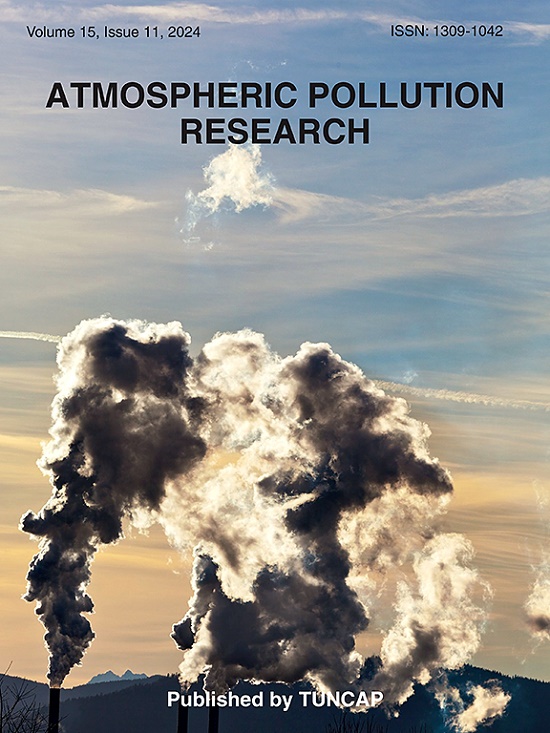碳化产品对减少家庭固体燃料燃烧污染物排放的影响
IF 3.9
3区 环境科学与生态学
Q2 ENVIRONMENTAL SCIENCES
引用次数: 0
摘要
在发展中区域,家庭固体燃料燃烧仍然是环境空气污染的一个主要来源。为了应对这一挑战,我们提出了一种碳化驱动的改性策略,即通过去除挥发性物质将低阶煤和农业秸秆转化为生物煤型煤。使用稀释取样系统的系统现场测量显示,半气化炉中碳化型煤的稳定燃烧显着减少了颗粒排放。具体而言,与原煤相比,含20%炭化秸秆的最佳混合物实现了PM2.5排放因子降低41.5% (3.7 vs. 4.9 mg/g),以及最低的总悬浮颗粒物(TSP, 3.92 mg/g)和PM1 (2.14 mg/g)。基于质量的有机碳(88.4±1.8%)、元素碳(88.8±2.5%)、16种重点多环芳烃(85±1.6%)和苯并芘(95±2.7%)的排放因子降低,而基于能量的重金属和有毒非金属(Pb、Cr、As等)的排放因子降低了13.95%。sem验证的颗粒形貌表明碳基体致密,碎片颗粒较少。至关重要的是,这项技术显示了双重好处:每年减少每户可吸入污染物的毒性当量,以及利用农村生物质废物分散生产的可行性。尽管秸秆碳化过程中的颗粒排放量高于煤炭(21.7 mg/g vs 12.1 mg/g),但在整个燃料生命周期中,碳化型煤的净排放量减少,使其成为资源有限的环境中向低排放家庭能源过渡的可扩展解决方案。本文章由计算机程序翻译,如有差异,请以英文原文为准。
Impact of carbonized products on reducing pollutant emission from household solid fuel combustion
Household solid fuel combustion remains a major source of ambient air pollution in developing regions. To address this challenge, we propose a carbonization-driven modification strategy by converting low-rank coal and agricultural straw into bio-coal briquettes through volatile removal. Systematic field measurements using a dilution sampling system revealed that stable combustion of carbonized briquettes in semi-gasifier stoves significantly reduced particulate emissions. Specifically, the optimal blend containing 20 % carbonized straw achieved a 41.5 % decrease in PM2.5 emission factor (3.7 vs. 4.9 mg/g) compared to raw coal, along with the lowest total suspended particulates (TSP, 3.92 mg/g) and PM1 (2.14 mg/g). Mass-based emission reductions were observed for organic carbon (88.4 ± 1.8 %), elemental carbon (88.8 ± 2.5 %), 16 priority PAHs (85 ± 1.6 %), and benzopyrene (95 ± 2.7 %), while energy-based emission factors of heavy metals and toxic nonmetals (Pb, Cr, As, etc.) decreased by 13.95 %. SEM-verified particle morphology indicated compact carbon matrices with fewer fragmented particulates. Crucially, this technology demonstrates dual benefits: a reduction in toxicity equivalency of inhalable pollutants per household annually, and decentralized production feasibility using rural biomass waste. Despite higher particulate emissions during straw carbonization than coal (21.7 vs. 12.1 mg/g), the net emission reduction across the fuel lifecycle positions carbonized briquettes as a scalable transition solution toward low-emission household energy in resource-limited settings.
求助全文
通过发布文献求助,成功后即可免费获取论文全文。
去求助
来源期刊

Atmospheric Pollution Research
ENVIRONMENTAL SCIENCES-
CiteScore
8.30
自引率
6.70%
发文量
256
审稿时长
36 days
期刊介绍:
Atmospheric Pollution Research (APR) is an international journal designed for the publication of articles on air pollution. Papers should present novel experimental results, theory and modeling of air pollution on local, regional, or global scales. Areas covered are research on inorganic, organic, and persistent organic air pollutants, air quality monitoring, air quality management, atmospheric dispersion and transport, air-surface (soil, water, and vegetation) exchange of pollutants, dry and wet deposition, indoor air quality, exposure assessment, health effects, satellite measurements, natural emissions, atmospheric chemistry, greenhouse gases, and effects on climate change.
 求助内容:
求助内容: 应助结果提醒方式:
应助结果提醒方式:


